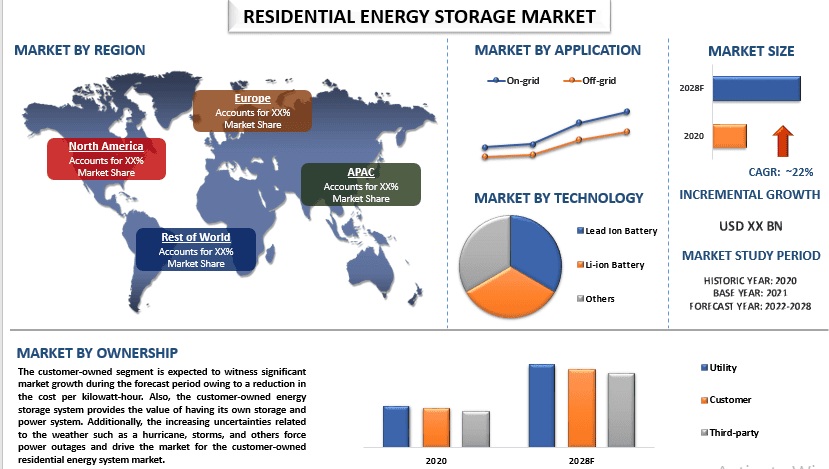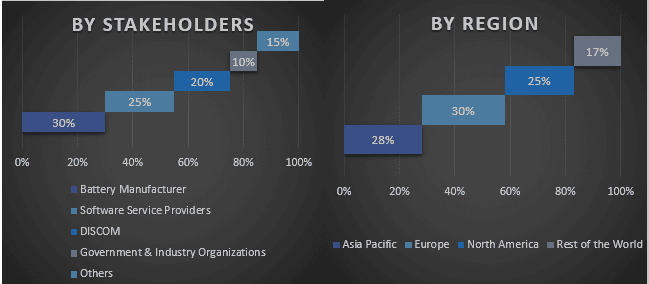- Home
- Chi siamo
- Settore
- Servizi
- Lettura
- Contattaci
Mercato dell'accumulo di energia residenziale: analisi attuale e previsioni (2022-2028)
Enfasi sulla tecnologia (batterie al piombo-ione, batterie agli ioni di litio e altro); Applicazione (On-Grid e Off-Grid); Proprietà (Utility, Cliente e Terze Parti); e Regione/Paese

RICHIEDI UN PDF DI ESEMPIO GRATUITO
Si prevede che il mercato globale dell'accumulo di energia residenziale crescerà a un tasso significativo di circa il 22% durante il periodo di previsione. I sistemi di accumulo di energia residenziale sono costituiti da una serie di batterie che consentono di utilizzare l'elettricità in eccesso in un secondo momento. A causa della crescente domanda di energia, del deterioramento delle infrastrutture elettriche e della necessità di mantenere la stabilità della rete, il settore dell'accumulo di energia residenziale ha registrato una domanda significativa. Inoltre, per l'ottimizzazione delle prestazioni e la riduzione dei costi operativi, il sistema di accumulo di energia domestica potrebbe essere combinato con fonti di energia rinnovabile come l'energia solare, eolica e altre risorse. Inoltre, il sistema di accumulo di energia domestica consente l'autoconsumo di energia fornendo al contempo energia a una tensione ridotta.
Tesla, Sonnen GmbH, Panasonic Industry, Enphase Energy, VARTA AG, ABB, Siemens AG, Eguana Technologies, BYD Company Ltd. ed Eaton sono alcuni dei principali attori del mercato. Diversi M&A, insieme a partnership, sono stati intrapresi da questi attori per offrire ai clienti prodotti/tecnologie hi-tech e innovativi.
Approfondimenti presentati nel rapporto
"Tra le applicazioni, la categoria on-grid assisterà a un CAGR più elevato durante il periodo di previsione"
In base all'applicazione, il mercato è suddiviso nei segmenti on-grid e off-grid. Si prevede che il segmento on-grid assisterà a un CAGR significativo durante il periodo di previsione a causa del suo crescente utilizzo negli edifici residenziali. Inoltre, l'accumulo di energia on-grid consente anche la fornitura di energia in eccesso all'azienda di servizi pubblici che controlla la rete e l'energia viene immagazzinata direttamente nel sistema della centrale elettrica. Inoltre, si prevede che nel prossimo futuro il mercato dell'accumulo di energia domestica on-grid crescerà a seguito di sviluppi tecnologici come i pannelli solari fotovoltaici, l'idrogeno/SNG e le batterie elettrochimiche.
"Tra le tecnologie, la batteria agli ioni di litio deterrà una quota significativa nel mercato nel 2020"
Sulla base della tecnologia, il mercato è segmentato in batterie al piombo-acido, batterie agli ioni di litio e altre. Si prevede che il segmento delle batterie agli ioni di litio assisterà a una significativa crescita del mercato durante il periodo di previsione a causa della sua elevata densità di energia, maggiore durata e alimentazione costante. Inoltre, rispetto alle batterie convenzionali, le batterie agli ioni di litio hanno un tasso di autoscarica inferiore e richiedono meno manutenzione. Inoltre, le batterie agli ioni di litio non necessitano di innesco e ogni cella è di circa 3,6 V, che è relativamente superiore rispetto alle batterie convenzionali. Inoltre, si prevede che il mercato aumenterà durante il periodo di previsione a causa del crescente sostegno del governo e degli investimenti nella produzione di batterie agli ioni di litio.
"L'Asia-Pacifico deterrà una quota significativa nel mercato"
Nel 2020, l'Asia-Pacifico deteneva una quota significativa del mercato globale dell'accumulo di energia residenziale. Ciò è principalmente attribuito alla rapida urbanizzazione e alla crescente domanda di elettricità nella regione. Inoltre, la crescente spesa per l'aggiornamento delle infrastrutture di rete, il progresso nella tecnologia delle batterie e diversi incentivi governativi per promuovere il sistema di accumulo di energia residenziale dovrebbero sostenere la crescita del mercato nella regione. Inoltre, si prevede che durante tutto il periodo di previsione, l'espansione del mercato nella regione sarà alimentata dal calo dei prezzi delle batterie agli ioni di litio, dai costi di produzione e produzione più economici e dalle minori spese per la manodopera. Ad esempio, nel giugno 2022, Toyota ha lanciato un sistema di accumulo di batterie residenziale da 5,5 kWh in grado di fornire l'output richiesto e potrebbe essere collegato alle installazioni solari fotovoltaiche sul tetto.
Motivi per acquistare questo rapporto:
- Lo studio include l'analisi della dimensione del mercato e delle previsioni convalidate da esperti del settore chiave autenticati.
- Il rapporto presenta una rapida panoramica delle prestazioni complessive del settore a colpo d'occhio.
- Il rapporto copre un'analisi approfondita dei principali concorrenti del settore con un focus primario sui principali dati finanziari aziendali, sul portafoglio prodotti, sulle strategie di espansione e sugli sviluppi recenti.
- Esame dettagliato dei driver, dei vincoli, delle tendenze chiave e delle opportunità prevalenti nel settore.
- Lo studio copre in modo completo il mercato attraverso diversi segmenti.
- Analisi approfondita a livello regionale del settore.
Opzioni di personalizzazione:
Il mercato globale dell'accumulo di energia residenziale può essere ulteriormente personalizzato in base alle esigenze o a qualsiasi altro segmento di mercato. Oltre a questo, UMI comprende che potresti avere le tue esigenze aziendali, quindi sentiti libero di metterti in contatto con noi per ottenere un rapporto che si adatti completamente alle tue esigenze.
Indice
Metodologia di ricerca per l'analisi del mercato dello stoccaggio di energia residenziale (2022-2028)
L'analisi del mercato storico, la stima del mercato attuale e la previsione del mercato futuro dello stoccaggio di energia residenziale globale sono stati i tre passaggi principali intrapresi per creare e analizzare l'adozione dello stoccaggio di energia residenziale nelle principali regioni a livello globale. È stata condotta un'esaustiva ricerca secondaria per raccogliere i dati storici del mercato e stimare le dimensioni del mercato attuale. In secondo luogo, per convalidare queste informazioni, sono stati presi in considerazione numerosi risultati e ipotesi. Inoltre, sono state condotte interviste primarie approfondite con esperti del settore lungo tutta la catena del valore del mercato globale dello stoccaggio di energia residenziale. Dopo l'ipotesi e la convalida dei dati di mercato attraverso interviste primarie, abbiamo impiegato un approccio top-down/bottom-up per prevedere le dimensioni complete del mercato. Successivamente, sono stati adottati metodi di scomposizione del mercato e di triangolazione dei dati per stimare e analizzare le dimensioni del mercato dei segmenti e sottosegmenti del settore pertinenti. La metodologia dettagliata è spiegata di seguito:
RICHIEDI PDF DI ESEMPIO GRATUITO
Analisi delle dimensioni storiche del mercato
Passaggio 1: Studio approfondito delle fonti secondarie:
È stato condotto uno studio secondario dettagliato per ottenere le dimensioni storiche del mercato dello stoccaggio di energia residenziale attraverso fonti interne all'azienda come relazioni annuali e bilanci, presentazioni sulle prestazioni, comunicati stampa, ecc., e fonti esterne tra cui riviste, notizie e articoli, pubblicazioni governative, pubblicazioni della concorrenza, rapporti di settore, database di terze parti e altre pubblicazioni credibili.
Passaggio 2: Segmentazione del mercato:
Dopo aver ottenuto le dimensioni storiche del mercato dello stoccaggio di energia residenziale, abbiamo condotto un'analisi secondaria dettagliata per raccogliere informazioni storiche sul mercato e condividere diversi segmenti e sottosegmenti per le principali regioni. I segmenti principali inclusi nel report sono tecnologia, applicazione e proprietà. Ulteriori analisi a livello di paese sono state condotte per valutare l'adozione complessiva dei modelli di test in quella regione.
Passaggio 3: Analisi dei fattori:
Dopo aver acquisito le dimensioni storiche del mercato di diversi segmenti e sottosegmenti, abbiamo condotto un'analisi dei fattori dettagliata per stimare le dimensioni attuali del mercato dello stoccaggio di energia residenziale. Inoltre, abbiamo condotto un'analisi dei fattori utilizzando variabili dipendenti e indipendenti come varie tecnologie, applicazioni e proprietà dello stoccaggio di energia residenziale. È stata condotta un'analisi approfondita degli scenari di domanda e offerta considerando le principali partnership, fusioni e acquisizioni, espansione aziendale e lanci di prodotti nel settore dello stoccaggio di energia residenziale in tutto il mondo.
Stima e previsione delle dimensioni attuali del mercato
Dimensionamento del mercato attuale: sulla base di informazioni utili derivanti dai 3 passaggi precedenti, siamo giunti alle dimensioni attuali del mercato, ai principali attori nel mercato globale dello stoccaggio di energia residenziale e alle quote di mercato dei segmenti. Tutte le suddivisioni percentuali necessarie e le scomposizioni del mercato sono state determinate utilizzando l'approccio secondario sopra menzionato e sono state verificate attraverso interviste primarie.
Stima e previsione: per la stima e la previsione del mercato, sono stati assegnati pesi diversi a vari fattori, tra cui driver e tendenze, vincoli e opportunità disponibili per le parti interessate. Dopo aver analizzato questi fattori, sono state applicate le tecniche di previsione pertinenti, ovvero l'approccio top-down/bottom-up, per arrivare alla previsione di mercato per il 2028 per diversi segmenti e sottosegmenti nei principali mercati a livello globale. La metodologia di ricerca adottata per stimare le dimensioni del mercato comprende:
- Le dimensioni del mercato del settore, in termini di entrate (USD) e il tasso di adozione del mercato dello stoccaggio di energia residenziale nei principali mercati a livello nazionale
- Tutte le quote percentuali, le suddivisioni e le ripartizioni dei segmenti e sottosegmenti di mercato
- I principali attori nel mercato globale dello stoccaggio di energia residenziale in termini di prodotti offerti. Inoltre, le strategie di crescita adottate da questi attori per competere nel mercato in rapida crescita
Convalida delle dimensioni e della quota di mercato
Ricerca primaria: sono state condotte interviste approfondite con i Key Opinion Leaders (KOL), inclusi Top Level Executives (CXO/VP, Sales Head, Marketing Head, Operational Head, Regional Head, Country Head, ecc.) nelle principali regioni. I risultati della ricerca primaria sono stati quindi riassunti ed è stata eseguita un'analisi statistica per dimostrare l'ipotesi dichiarata. Gli input della ricerca primaria sono stati consolidati con i risultati secondari, trasformando quindi le informazioni in informazioni fruibili.
Ripartizione dei partecipanti primari nelle diverse regioni

Ingegneria del mercato
È stata impiegata la tecnica di triangolazione dei dati per completare la stima complessiva del mercato e per ottenere numeri statistici precisi per ciascun segmento e sottosegmento del mercato globale dello stoccaggio di energia residenziale. I dati sono stati suddivisi in diversi segmenti e sottosegmenti dopo aver studiato vari parametri e tendenze nelle aree della tecnologia, dell'applicazione e della proprietà nel mercato globale dello stoccaggio di energia residenziale.
L'obiettivo principale dello studio sul mercato globale dello stoccaggio di energia residenziale
Le tendenze di mercato attuali e future del mercato globale dello stoccaggio di energia residenziale sono state individuate nello studio. Gli investitori possono ottenere informazioni strategiche per basare la propria discrezione per gli investimenti sull'analisi qualitativa e quantitativa eseguita nello studio. Le tendenze di mercato attuali e future hanno determinato l'attrattiva complessiva del mercato a livello regionale, fornendo una piattaforma per il partecipante industriale per sfruttare il mercato non sfruttato per beneficiare di un vantaggio di first-mover. Altri obiettivi quantitativi degli studi includono:
- Analizzare le dimensioni del mercato attuale e previsto del mercato dello stoccaggio di energia residenziale in termini di valore (USD). Inoltre, analizzare le dimensioni del mercato attuale e previsto di diversi segmenti e sottosegmenti.
- I segmenti nello studio includono aree di tecnologia, applicazione e proprietà.
- Definire e analizzare il quadro normativo per lo stoccaggio di energia residenziale
- Analizzare la catena del valore coinvolta con la presenza di vari intermediari, insieme all'analisi del comportamento dei clienti e dei concorrenti del settore.
- Analizzare le dimensioni del mercato attuale e previsto del mercato dello stoccaggio di energia residenziale per la principale regione.
- I principali paesi delle regioni studiate nel rapporto includono Asia Pacifico, Europa, Nord America e il resto del mondo.
- Profili aziendali del mercato dello stoccaggio di energia residenziale e le strategie di crescita adottate dagli operatori di mercato per sostenere nel mercato in rapida crescita
- Analisi approfondita a livello regionale del settore
Correlati Report
I clienti che hanno acquistato questo articolo hanno acquistato anche










